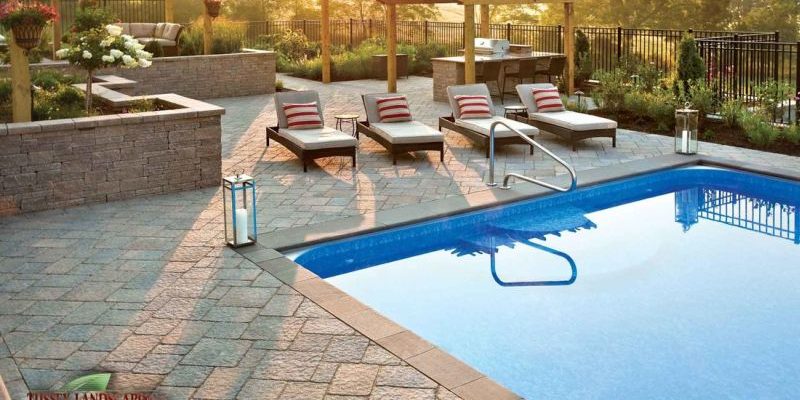
It’s a question that’s been raised time and again by professionals, do-it-yourself enthusiasts, and homeowners looking to make a wise investment decision.
- Which one will last longer?
- Which one will cost more?
- What will look better on my property?
It’s important to understand that both concrete and pavers have a place, and what’s best for one area may not fit another. To understand how these products differ, we first must clarify what we’re talking about, and how the products are similar.
Concrete
When we speak of concrete, we’re generally talking about a single (monolithic, to be technical), poured concrete slab. This concrete is usually reinforced with wire or rebar and can be smooth finished or textured. Stamped concrete often falls into this category, although there are some other differences between stamped and regular concrete.
Concrete is usually poured either directly on the prepared site ground, or ideally, on a bedding layer of at least 2 inches of clean stone. Most public sidewalks and curbs, garage floors, and residential concrete projects are done this way.
Patio Pavers
Most paving stones—or pavers, as we call them—are made from a pre-cured concrete. There are also clay bricks and natural stone products, but for simplicity, we’ll focus on concrete paving stones.
Pavers don’t have wire or rebar grid in them. Instead, their strength comes from the interlocking pavers around them, and the weight distribution that it provides. Pavers require more extensive base work. Our recommendation is to have at least a 6-inch crushed stone base and a 1-inch layer of bedding sand. All correctly installed residential paver walkways and patios require this minimum, while driveways and industrial jobs require much more.
A Head-to-Head Comparison
In four-season climates like ours in Pennsylvania, both materials are subject to moving ground caused by the freeze and thaw of the soil below them, and they behave in different ways.
Since concrete is a single “free-floating” slab, either the entire piece of concrete will move up or down, or it will crack. This movement is what causes the uneven bumps to appear along the joints in a sidewalk and cracks to appear in the previously smooth patio. Contractors avoid this problem by putting “safety cracks” in the concrete. However, over time, concrete will still tend to crack and heave, which cannot be repaired.
You can think of pavers as many small concrete slabs locked together. Freeze and thaw cycles will move pavers too. However, each joint between two pavers allows for a bit of flex and movement. In this way, pavers can move with the freeze, and will settle back into place without leaving any bumps or cracks. In both cases, this movement is usually minimal; unfortunately, if the concrete flexes more than 0.125 inches, it will crack.
Pricing of Concrete vs. Stamped Pavers
Initially, a poured concrete slab will be cheaper to install than a paver area of the same size. Poured concrete requires less base work and preparation and is less labor intensive than pavers. There are some risks to be considered with this installation. Once the concrete slab is poured, it is permanent. If a crack develops, or a corner is chipped, it is usually costly to fix. Repairs often require cutting a patch out or demolishing the entire pad and re-pouring it. The contractor might repair any issues related to the original construction. But any cracks, chips, or problems that occur after installation will incur additional cost for the homeowner.
Pavers cost more to install but are less costly to repair or alter. If a single paver is chipped or marred, it can be removed and replaced with little difficulty. When properly installed, no cracks or gaps should appear. Most pavers come with a warranty on the quality of the pavers. Many contractors offer a warranty on their work for two to five years or longer.
Concrete offers a range of color variations created by dyeing the wet (not yet poured) concrete a particular color, which is done on the day of the installation. Concrete can be stamped with a pattern or finished with several different texture options.
Pavers offer an almost endless avenue of artistic opportunity. Many pavers have several color options, and various pavers can be used together to create contrast or complementing borders and color schemes. You can choose from varying textures to create a certain feel – from a smooth, modern design or an aged, textured feel.
Patterns can be made with pavers as well. For ideas on color, texture, pattern, visit our Hardscape Project Gallery .
Pavers can also be used to correspond with color-matching retaining walls, steps, fireplaces and more. If your location isn’t flat and grading work must be done, consider the possibilities of combining Pavers and walls to complement each other.
Final Thoughts
Here are a few questions to consider as you plan your hardscaping project:
- What is your budget for installation?
- Have you figured in for any extra costs or unforeseen changes?
- What purpose will this hardscape serve?
- Is this project a functional solution to a problem or an aesthetic addition to your home?
Ultimately, the choice is yours.
